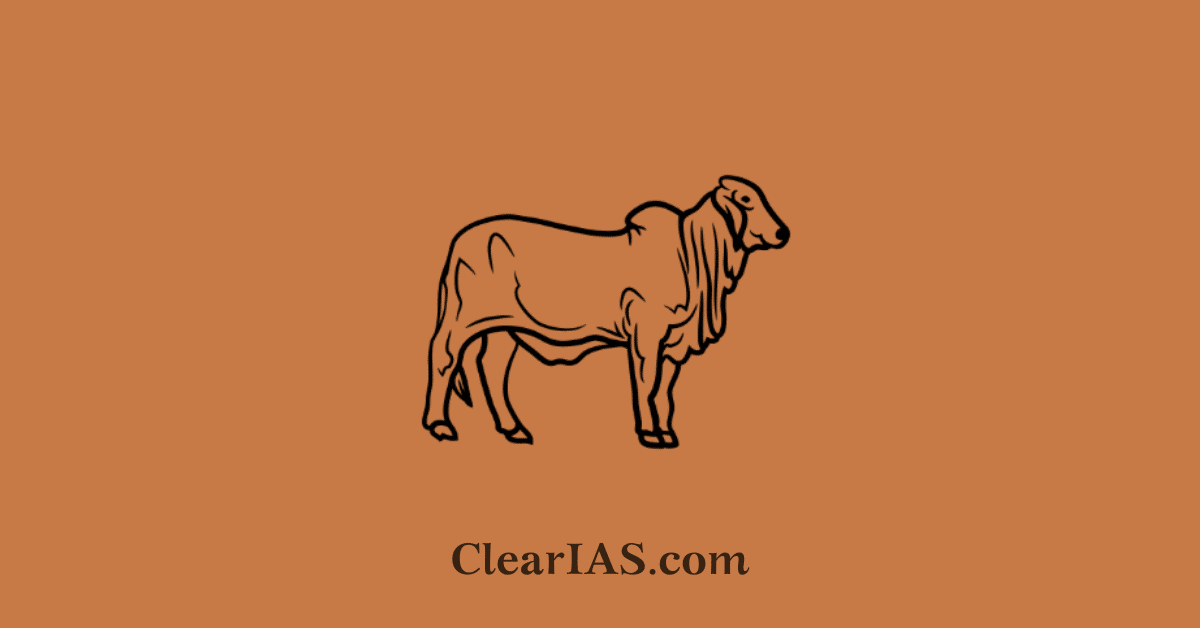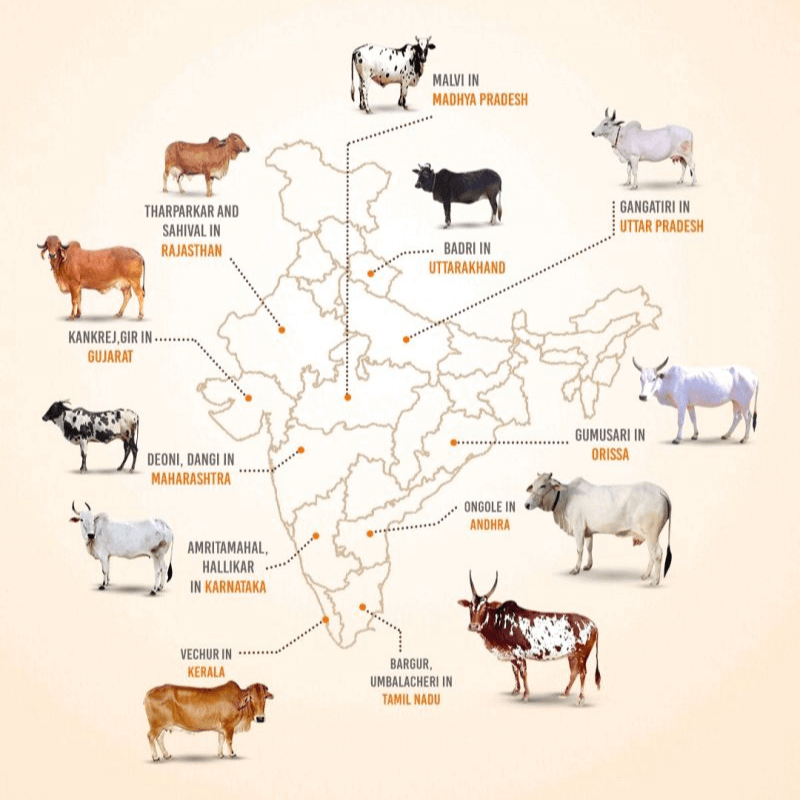
The Rashtriya Gokul Mission is an initiative launched by the Indian government to conserve and develop indigenous cattle breeds in the country. Read here to learn the progress of the mission.
The mission was initiated to promote and improve the productivity of cattle, enhance the livelihood of farmers, and ensure the sustainable use of native cattle genetic resources.
As the mission nears a decade of implementation, it is being reported that instead of improving the quality of all the indigenous breeds, as envisioned under the scheme, it has ended up promoting only one indigenous variety, the Gir cow, across the country.
This trend, if not corrected, could end up threatening the purity of indigenous breeds across the country.
Rashtriya Gokul Mission
The Rashtriya Gokul Mission (RGM) has been implemented for the development and conservation of indigenous bovine breeds since December 2014.
- The scheme is important in enhancing milk production and productivity of bovines to meet the growing demand for milk and making dairying more remunerative to the rural farmers of the country.
- The scheme was also continued under the umbrella scheme Rashtriya Pashudhan Vikas Yojna from 2021 to 2026 with a budget outlay of Rs.2400 crore.
- The RGM was envisioned to result in enhanced productivity and benefit of the program, percolating to all cattle and buffaloes of India, especially with small and marginal farmers.
- This program also benefits women in particular since over 70% of the work involved in livestock farming is undertaken by women.
Objectives
- To enhance the productivity of bovines and sustainably increase milk production using advanced technologies.
- To propagate the use of high genetic merit bulls for breeding purposes.
- To enhance Artificial insemination coverage through strengthening the breeding network and delivery of Artificial insemination services at farmers’ doorstep.
- To promote indigenous cattle & buffalo rearing and conservation scientifically and holistically.
Funding Pattern
All the components of the Scheme will be implemented on a 100% grant-in-aid basis except the components of:
- accelerated breed improvement program under the component subsidy of Rs 5000 per IVF pregnancy will be made available to participating farmers as GoI shares;
- promoting sex-sorted semen under the component subsidy up to 50% of the cost of sex-sorted semen will be made available to participating farmers and
- establishment of a breed multiplication farm under the component subsidy up to 50% of the capital cost maximum up to Rs.2.00 crore of the project will be made available to entrepreneurs.
Components of the Rashtriya Gokul Mission
- National Kamdhenu Breeding Center: The mission involves the establishment of National Kamdhenu Breeding Centers to conserve and propagate high genetic merit indigenous breeds.
- Integrated Indigenous Cattle Centers (Gokul Grams): These centers serve as focal points for the development and propagation of indigenous cattle breeds. They provide training, research, and extension services.
- Incentives for Farmers: The government provides financial incentives to farmers and livestock keepers who are involved in the conservation and improvement of indigenous cattle breeds.
- Genetic Upgradation of Indigenous Cattle: This component focuses on the use of advanced reproductive technologies and the promotion of elite indigenous cattle breeds to improve genetic merit.
- Feed and Fodder Development: Ensuring the availability of quality feed and fodder for cattle is vital, and the mission supports initiatives in this area.
- Strengthening Cattle Markets: The mission works to strengthen cattle markets, improve cattle trade, and promote cattle-based entrepreneurship.
- Monitoring and Evaluation: There are provisions for monitoring and evaluation of the mission’s progress and its impact on indigenous cattle breed conservation.
Significance of the RGM
- Conservation of Indigenous Breeds: The primary objective of the mission is to conserve and develop indigenous cattle breeds, which are well-suited to the Indian climate and contribute to the rural economy.
- Enhancing Productivity: The mission aims to improve the genetic makeup of indigenous cattle through selective breeding, assisted reproductive technologies, and other scientific interventions. This, in turn, is expected to enhance the productivity of these cattle in terms of milk and meat production.
- Increase Livelihoods: By improving cattle productivity, the mission intends to increase income and livelihood opportunities for farmers, especially those engaged in dairy farming.
- Promote Sustainable Agriculture: The mission emphasizes the importance of cattle in sustainable agricultural practices and aims to promote the use of native cattle for plowing, organic farming, and manure production.
- Conservation of Germplasm: It focuses on preserving the germplasm of indigenous cattle breeds to ensure their genetic diversity and future availability.
- Capacity Building: The mission includes capacity-building activities for farmers, livestock owners, and cattle breeders to enhance their knowledge and skills in cattle management and breeding practices.
Indigenous bovines in India

India is known for its rich diversity of indigenous cattle breeds. These breeds have adapted to various ecological and climatic conditions across the country. Indigenous bovines are valued for their milk, and meat, and as draft animals.
- Gir: Originally from the Gir forest region in Gujarat, Gir cattle are known for their high milk yield and are often used for dairy production. They have a distinctive hump on their shoulders.
- Sahiwal: Sahiwal cattle are native to the Sahiwal district in Pakistan but are also found in parts of India. They are highly productive milk cattle and are well adapted to hot and arid climates.
- Red Sindhi: Red Sindhi cattle are indigenous to the Sindh region and are found in parts of India. They are used for both milk and meat production and are known for their hardiness.
- Tharparkar: Tharparkar cattle are primarily found in the Tharparkar district of Sindh, Pakistan, and India’s Rajasthan region. They are well-suited to arid conditions and are valued for their milk production.
- Deoni: Deoni cattle are native to the Deoni region in Maharashtra and Karnataka. They are dual-purpose cattle, suitable for milk and draft work. Deoni bullocks are used for plowing and transportation.
- Ongole: Also known as Nellore cattle, Ongole cattle are from the Andhra Pradesh region. They are known for their strength and are commonly used in agricultural operations and as draught animals.
- Kankrej: Kankrej cattle are found in the Kankrej region of Gujarat. They are well-adapted to hot and arid conditions and are often used in agricultural work.
- Vechur: Vechur cattle are a small-sized breed found in the Vechur region of Kerala. They are known for their high milk fat content and are considered a dwarf breed.
- Malvi: Malvi cattle are from the Malwa region of Madhya Pradesh and are used for both milk and draft purposes.
- Hallikar: Hallikar cattle are native to Karnataka, particularly in the Hassan and Tumkur districts. They are strong draught animals.
- Amrit Mahal: This breed is indigenous to Karnataka and is known for its robustness and draught capabilities. They were historically used by the kings of Mysore for war elephants.
- Punganur: Punganur cattle, from the Punganur region of Andhra Pradesh, are small-sized and known for their high milk yield relative to their size.
- Khillar: Khillar cattle are from Maharashtra and are hardy animals used for both milk and draught work.
- Kherigarh: Kherigarh cattle are found in the Kheri district of Uttar Pradesh. They are dual-purpose cattle used for milk and farming activities.
- Amritmahal: Amritmahal cattle are native to Karnataka and are strong draught animals. They are known for their ability to carry heavy loads and plow fields.
Challenges of the RGM scheme
The initiative was started with the idea that research would be carried out on a host of high milk-yielding indigenous bovine varieties such as Sahiwal, Tharparkar, and Red Sindhi, and then depending on the geographical location, the high-quality semen would be used to impregnate other indigenous varieties.
- In practice, almost all states are demanding Gir varieties for carrying out artificial insemination.
- Instead of improving the quality of all the indigenous breeds, as envisioned under the scheme, it has ended up promoting only one indigenous variety, the Gir cow, across the country.
- The reason behind the popularity of Gir stems from the fact that the mission was started in Chhattisgarh and Madhya Pradesh where milk production of indigenous bovine varieties impregnated with Gir increased by three to four liters a day.
- Being a native of the west and central parts of India, Gir can adapt to the entire central belt and northern and southern stretches.
- In contrast, Sahiwal, a native of Northern India or Tharparkar, from the Northwest, does not adapt as well to new environments.
The long-term challenge with the way the Mission is being implemented is that the country might end up losing purebred varieties of indigenous bovines.
In news
The breed of Ongole cattle Viatina-19 recently made headlines in Brazil by fetching an astonishing $4.82 million (about 41 crores) at an auction, making it the most expensive cow in the world.
This sale surpassed even Japan’s famed Wagyu and India’s Brahman breeds, demonstrating the immense value of Ongole cattle when developed with proper care and scientific breeding.
- Originally native to AP’s Prakasam district, Ongole cattle are known for their unique genetic traits, including exceptional physical strength, heat resistance, and superior muscular structure.
- These qualities make them highly desirable for dairy.
- However, while India’s breed struggles for attention and preservation, countries like Brazil have harnessed its full potential, generating enormous wealth through its fine germplasm.
Way forward
The indigenous cattle breeds are crucial for India’s agricultural economy and have adapted to various local conditions. However, many of these breeds are under threat due to crossbreeding and the introduction of exotic breeds. Conservation efforts are underway to protect and preserve these valuable genetic resources.
The Rashtriya Gokul Mission is a significant step toward conserving and promoting India’s native cattle breeds, which are well-adapted to local conditions and play a crucial role in the livelihoods of millions of farmers in the country. By improving their genetic potential and productivity, the mission contributes to both agricultural sustainability and rural economic development.
But if the constant crossbreeding of indigenous varieties continues then over time the graded varieties might completely lose the region-specific traits. This will be a repeat of Jersey crossbreeding with Indian varieties during the white revolution. Even though the country’s milk production increased, it did not translate into higher income for livestock rearers as the crossbred cows were more prone to diseases and required more care.
Related articles: Economics of Animal rearing; Sustainable Livestock Production
-Article by Swathi Satish





Leave a Reply